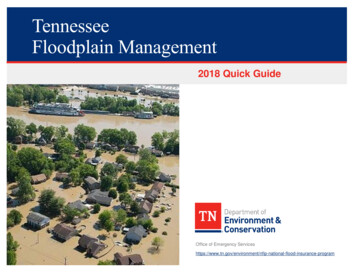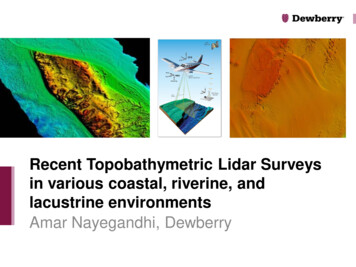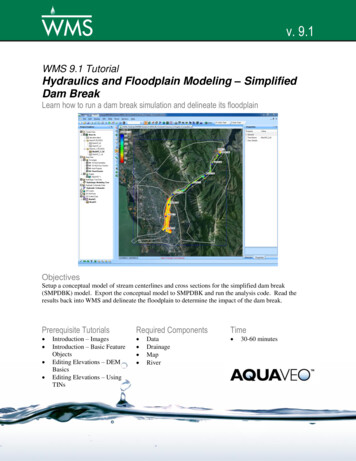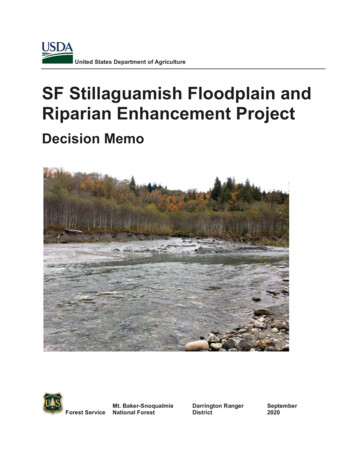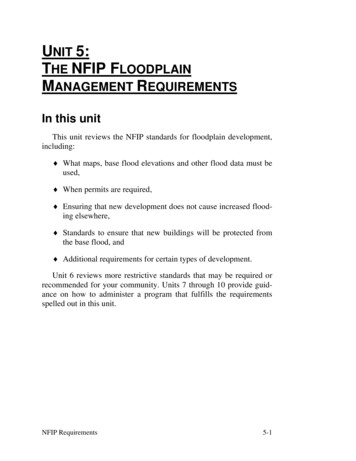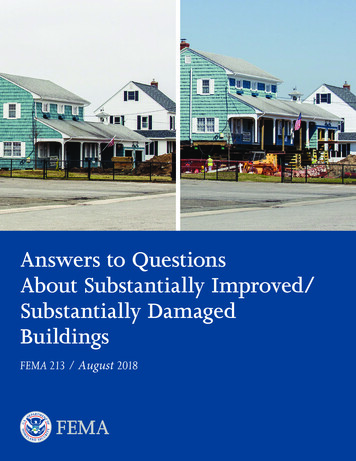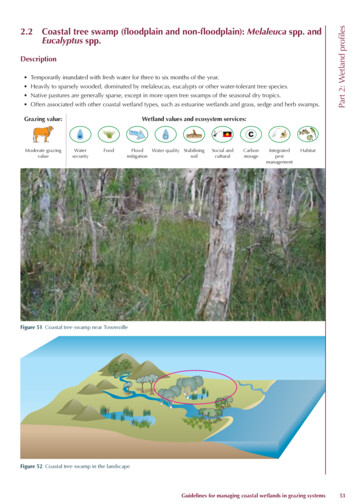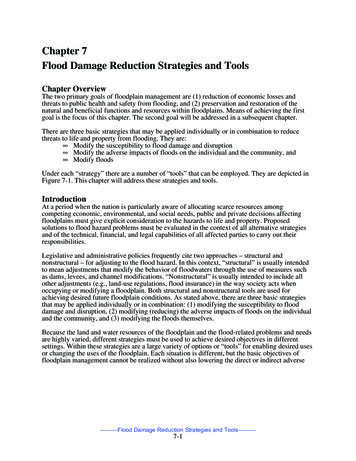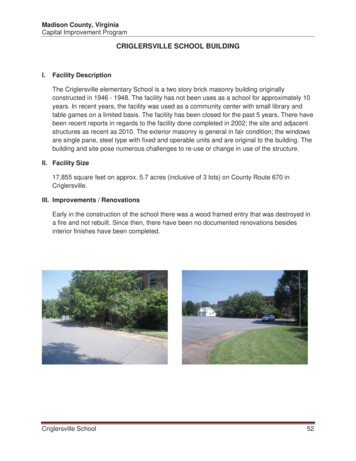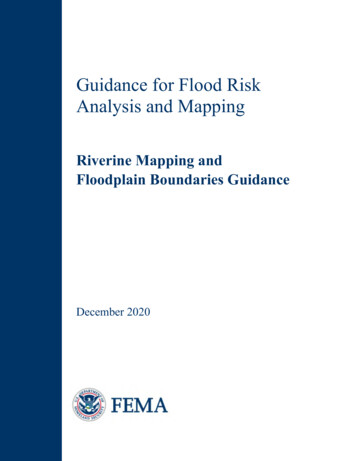
Transcription
Guidance for Flood RiskAnalysis and MappingRiverine Mapping andFloodplain Boundaries GuidanceDecember 2020
Requirements for the Federal Emergency Management Agency (FEMA) Risk Mapping,Assessment, and Planning (Risk MAP) Program are specified separately by statute, regulation,or FEMA policy (primarily the Standards for Flood Risk Analysis and Mapping). This documentprovides guidance to support the requirements and recommends approaches for effective andefficient implementation. Alternate approaches that comply with all requirements are acceptable.For more information, please visit the FEMA Guidelines and Standards for Flood Risk Analysisand Mapping webpage nes-standards).Copies of the Standards for Flood Risk Analysis and Mapping policy, related guidance, technicalreferences, and other information about the guidelines and standards development process areall available here. You can also search directly by document title at www.fema.gov/multimedialibrary.Riverine Mapping and Floodplain GuidanceGuidance Document 60December 2020Page i
Document HistoryAffected Section orSubsectionDateDescriptionSections 4.0 and 6.0December2020This guidance has been updated to add informationregarding evaluation lines for 2D modeling.Riverine Mapping and Floodplain GuidanceGuidance Document 60December 2020Page ii
Table of Contents1.0Riverine Mapping and Floodplain Boundaries Overview . 12.0Redelineation . 23.0Mapping of One-Dimensional Riverine Analyses . 44.0Mapping of Two-Dimensional Riverine Analyses . 45.0Floodway Mapping. 56.0Base Flood Elevation Line Placement . 67.0Floodway and Flood Hazard Tie-Ins; Boundary Post-Processing . 7Riverine Mapping and Floodplain GuidanceGuidance Document 60December 2020Page iii
1.0Riverine Mapping and Floodplain Boundaries OverviewThis document provides guidance for riverine mapping and floodplains, and all the componentsthat accompany it. FEMA prepares flood hazard mapping to create broad-based awareness offlood risk, provide data necessary for mitigation programs, and rate flood insurance for specificproperties. Each floodplain or flood hazard area is divided into flood insurance rate zones that arebased on the floodplain boundaries determined on a work map. Areas within the1 percent annual-chance (100-year) floodplain boundary are typically termed Special FloodHazard Areas (SFHA). Areas between the 1- and 0.2-percent-annual-chance (500-year)floodplain boundaries are termed areas of moderate flood hazard. The remaining areas abovethe 0.2-percent-annual-chance floodplain are termed areas of minimal flood hazard.For all types of riverine and floodplain mapping the assigned Mapping Partner should provide, indraft format, a neatly compiled work map that contains the flood hazard data necessary to producethe Preliminary version of the Flood Insurance Rate Map (FIRM). This will be included in ahydraulics or floodplain mapping submission. This will assist in outreach with the communitythrough a flood risk review meeting. The Mapping Partner should coordinate with the region todetermine work map specifications. The work map is typically the topographic map used todelineate the updated floodplain boundaries and/or the base map to be used for FIRM production.The assigned Mapping Partner shall submit the work map in digital form unless otherwiseapproved by the FEMA Lead. The assigned Mapping Partner shall submit the compiled work map(original copy) and/or plots of the digital files as part of the Technical Support Data Notebook(TSDN).Whenever possible, the assigned Mapping Partner shall ensure that the work map, which shallbe prepared in “FIRM-ready” format whenever possible, complies with the following guidelines: Use the same base map that FEMA will use for FIRM production for the base map. Use the proposed FIRM panel tiling and numbering scheme (this tiling applies only to hardcopy maps). Prepare individual work map panels at the same scale as the FIRM panels. Use labels, legends, and notes that are compatible with the FEMA FIRM graphicspecifications provided in the FIRM Panel Technical Reference and FIRM GraphicsGuidance. Submit digital data in a seamless format (see FIRM Database Technical Reference).If the assigned Mapping Partner is not required to prepare the work map in a “FIRM-ready” format,the Mapping Partner may submit the work map as strip maps, covering the revised floodplainareas. At a minimum, the work map should cover all areas with updated flood hazard data.Additionally, planimetric features and orthophotos should be compatible with those shown on thebase map to be used for FIRM production.The designated Mapping Partner shall ensure that the effective and revised flood hazard data arecompiled into seamless data with no discontinuities. All inconsistencies between new/revisedRiverine Mapping and Floodplain GuidanceGuidance Document 60December 2020Page 1
flood hazard data and unrevised flood hazard data should be identified during the Project Scopingphase and resolved as appropriate in consultation with the FEMA Lead before work commences.The Mapping Partner responsible for the flood hazard data development shall ensure that revisedflood hazard data ties in well to the effective flood hazard data. The potential mismatches shouldhave been identified during the scoping phase and addressed at that time. Any problematicresidual tie-in issues shall be brought to the attention of the FEMA Project Officer for review andresolution.All floodplain mapping described in this Guidance Document contracted afterSeptember 2, 2005, should conform with Floodplain Boundary Standards (FBS). For Guidanceon FBS see Guidance Document #49, Floodplain Boundary Standards.2.0RedelineationRedelineation of riverine floodplains is a useful technique for updating flood hazard informationfor an effective riverine analysis that is considered valid. Redelineation is often used wheneffective discharges and Base Flood Elevations (BFEs) appear accurate, but the SFHA seemsinaccurate (e.g., flooding losses in Zones B, C, or X; numerous Letters of Map Amendment;comparison with accurate topographic data). The flood boundaries are delineated by finding theintersection of the ground surface defined by the underlying digital terrain model and the floodsurface. Redelineation involves using more detailed topographic data than what was used toprepare the effective FIRM, in order to remap the floodplain boundaries based on the floodelevations used in preparing the effective FIRM. Redelineation is to be limited to floodplainsstudied by detailed methods where BFEs or flood depths are designated on the effective FIRM.However, if elevation or depth data have been generated for a flooding source for which onlyapproximate analyses were performed by FEMA, redelineation may be applied to the Zone Afloodplain boundaries as well.Prior to the redelineation of effective floodplain boundaries, the assigned Mapping Partner shouldperform the following activities to assess the appropriateness of this approach: Review the planimetric features surveyed during the topographic data developmentprocess to ensure that the horizontal accuracy is compatible with the selected FIRM basemap. Review the effective 1- and 0.2-percent-annual-chance flood elevations to ensure thatthey are valid and usable for the floodplain boundary redelineation process. If conditionshave changed such that the Flood Profiles included in the effective Flood Insurance Study(FIS) Report no longer represent existing conditions (e.g., if bridge or culvert constructionhas occurred), the assigned Mapping Partner may need to perform updated hydrologicand hydraulic analyses and\or investigate if a Letter of Map Revision (LOMR) has beenperformed at that location which would need to be taken into account. The assignedMapping Partner shall obtain the required approval from the FEMA Lead beforeproceeding with such analyses. Investigate changes in planimetric or topographic conditions that indicate the need forupdated analyses and may preclude the use of this method. Such situations would includeRiverine Mapping and Floodplain GuidanceGuidance Document 60December 2020Page 2
significant possible floodplain violations by communities, discrepancies in planimetricfeatures, topography, or stream distance between Flood Profiles and topographicmapping. The assigned Mapping Partner shall bring these situations to the attention of theFEMA Lead.Redelineation involves no new analyses. Redelineation uses effective information such as theflood profiles and floodway data tables from the FIS report, BFEs from the FIRM, and supportinghydrologic and hydraulic analyses and new topographic data that are more up-to-date and/ormore detailed than those used to produce the floodplain boundaries shown on the effective FIRM.In many cases, mapping cross sections with interpolated water surface elevations (WSEL) shouldbe derived to supplement effective cross section data, in order to ensure completeness of theresulting redelineated floodplain boundaries.Possible sources of existing topographic data include local planning departments, GeographicInformation System (GIS) coordinators, engineers, public works departments, FEMA archives,and state Departments of Transportation.Detailed specifications for topographic data and field surveys are contained in FEMA GuidanceDocument No. 47, Elevation Guidance. Guidance Document No. 47 is also accessible throughthe FEMA Guidelines and Standards for Flood Risk Analysis and Mapping webpage ines-standards. In order to evaluate thesuitability of existing topographic data, the Project Management Team shall consider the followingfactors: Contour Mapping or Digital Elevation Models: contour interval should be 4 feet or less (2feet in flat terrain). Currency of data: if significant changes exist (e.g., highways, subdivisions, and/or mining).In some cases it may be possible to utilize only portions of updated topographic data inorder to perform the redelineation. If a question about the currency/accuracy oftopographic data exists, users should reference the metadata record, or contact the dataowner for verification. Additionally, comparative analyses should be performed to verifythe accuracy of topographic data in reference to past and present ground conditions.The topographic data and the base map data used for the FIRM must be compatible. Features inboth data sources must align and show current ground conditions. If suitable existing topographicdata are not available, it will be necessary to develop new topographic and/or survey data.Guidance Document No. 47 provides the requirements for developing new topographic data andperforming cross-section and structure surveys.When re-delineating effective flood hazard data, if WSEL are not available for all cross sections,the Mapping Partner must generate that elevation data from the corresponding streams’ FloodProfile in the effective FIS report. The cross sections must traverse the floodplain and be orientedperpendicular to the direction of flow. The Mapping Partner must use the complete set of effectivehydraulic cross sections to develop the required flood profiles. If the topographic data used in theredelineation differs significantly from the topographic data used to create the effective modelindicating that the effective hydraulic analyses are no longer valid, the Mapping Partner mustcoordinate further actions with the FEMA Project Officer.Riverine Mapping and Floodplain GuidanceGuidance Document 60December 2020Page 3
All data for redelineation must be submitted in digital format. The Mapping Partner performing“Floodplain Mapping” for redelineation is required to submit the data described in Data CaptureTechnical Reference.3.0Mapping of One-Dimensional Riverine AnalysesUpon completion of a one-dimensional analysis the Mapping Partner, at a minimum, mustdelineate the floodplain and floodway boundaries of the base flood. The Mapping Partner mustalso delineate the floodplain boundaries associated with the 0.2-percent-annual-chance flood, ifit is calculated.The flood boundaries are delineated by finding the intersection of the ground surface defined bythe underlying digital terrain model and the flood surface. Floodplain boundaries are delineatedon the best available topographic mapping using the water-surface elevations determined at crosssections. Between cross sections, WSELs are interpolated. The interpolation is linear alongsmooth lines following the general direction of the flow close to the boundary. The topographicmapping should be digital, accommodating an automated or semi-automated floodplain mappingalgorithm; manual delineation should be used only if digital topographic data are not available.Final boundaries should be reviewed for hydraulic reasonableness based on the best topographicinformation, the hydraulic modeling results, photographs, flood profile information, andengineering judgment.The floodplain boundaries must be shown in a georeferenced spatial file, as defined in section6.9 of the Data Capture Technical Reference, and in section 9 of the FIRM Database TechnicalReference. If inspection of this file does not demonstrate that the cross sections (and/or BFElines) are aligned perpendicular to the flow, in the submittal special considerations documentationdescribed in Data Capture Technical Reference the Mapping Partner must document why,contrary to what may be indicated, the flow direction is in fact perpendicular to each cross section.4.0Mapping of Two-Dimensional Riverine AnalysesTwo-dimensional flood analysis results in a (regular or irregular) grid of flood elevation values.Each cell in the model is attributed with a flow direction and flood elevation or is designated asnot flooded or dry. The floodplain is delineated using the collection of cells with flood elevations.Although rare, non-conveyance areas may be input into the two-dimensional model usingartificially high roughness values. The Mapping Partner should ensure that non-conveyance areasthat should be included in the floodplain are mapped as such.If the flood elevation grid cannot be used directly in GIS software as a digital surface, the MappingPartner should develop such a surface. Most GIS software contains options to develop such asurface. The floodplain boundaries are delineated by either finding the intersection of the groundsurface defined by the underlying digital terrain model and the flood surface, or subtracting theground surface grid from the WSEL grid and finding the boundaries of those cells with differences(i.e., flood depths) greater than zero. The Mapping Partner must fully document the methods usedto develop the flood surface and to determine flood boundaries.Riverine Mapping and Floodplain GuidanceGuidance Document 60December 2020Page 4
The Mapping Partner should delineate BFE contour lines using the digital flood surface. Thecontour interval should be sufficient to discern the flow direction at any point within the floodplain.The Mapping Partner should verify that the flow directions indicated by the contour lines agreewith the flow directions in the output grid.The flood boundaries, evaluation lines, and BFE lines must be provided in a georeferenced spatialfile as defined in section 6.9 of the Data Capture Technical Reference, and Section 9 of the FIRMDatabase Technical Reference. If necessary, for presentation purposes, the Mapping Partnershould smooth the boundaries and contour lines. In lieu of Flood Profiles, the flood elevation gridmay be utilized by map users to interpolate between the flood surface contour lines. For additionalguidance on accurately representing the flood water surface please refer to the Mapping BaseFlood Elevations on Flood Insurance Rate Maps Guidance document.5.0Floodway MappingThe floodway is a tool to assist communities in balancing development within the floodplainagainst the resulting increase in flood hazard. The Mapping Partner should coordinate with thecommunity when developing floodways as early as possible in the study process, and moredetailed guidance can be found in the Floodway Analysis and Mapping Guidance document. Aregulatory floodway is defined as the channel of a river or other watercourse and the adjacentland area that is reserved from encroachment in order to discharge the base flood withoutcumulatively increasing the water-surface elevation, or surcharge, by more than a designatedheight.For one-dimensional riverine analyses, floodways are delineated at encroachment stations (limitsof conveyance) at cross sections and delineated between cross sections. The floodwayboundaries must be smooth lines following the general direction of floodwaters, graduallywidening or narrowing to reflect the changes in width between cross sections. The floodway mustbe shown in a georeferenced spatial file submitted as part of the hydraulics and floodplainsubmittal described in Section 6.6 of the Data Capture Technical Reference, and Section 9 of theFIRM Database Technical Reference. Floodway boundaries should be mapped at the channelbank stations when the floodway surcharged elevation is lower than the channel bank elevationor the base flood is contained within the channel. If a floodway exists upstream or downstream ofthe study reach, the floodway data for the study reach must be contiguous with the floodway datafor the existing study.For two-dimensional riverine analyses, floodways should be delineated using the encroachmentboundaries determined in the floodway model.Unlike one-dimensional analyses, theencroachment boundaries from a two-dimensional floodway analysis cover the entire modeledreach and can be used to set the floodway boundary directly. The final boundary should besmooth, using the same methods used to delineate the floodplain.Regulatory floodways are not normally delineated in coastal high-hazard areas (i.e., ZonesV1-30, VE, and V). For more information about mapping floodways near coastal zones refer toSection 2.2 of Combined Coastal and Riverine Floodplain guidance.Riverine Mapping and Floodplain GuidanceGuidance Document 60December 2020Page 5
Where the floodway is mapped differently than the model results in order to meet staterequirements, the Mapping Partner should document the state requirements and the location(s)that discrepancies occur.6.0Base Flood Elevation Line PlacementWSELs of the 1-percent-annual-chance (base) flood are called BFEs. The BFEs may bedesignated on the FIRM using BFE lines, evaluation lines or cross sections. Where mappingresults are based on a one-dimensional hydraulic analysis the use of BFE lines is only requiredin special cases. Whole-foot BFEs (i.e., 1-percent-annual-chance WSEL values located with BFElines) are shown at appropriate locations to allow map users to estimate 1-percent-annual-chanceflood elevations. BFE lines must traverse the floodplain and be oriented perpendicular to thedirection of flow. BFE lines must not cross each other or cross sections delineated in thegeoreferenced spatial file. BFE lines are to be plotted at significant profile inflection points (profilebreaks) where flood elevations are not reported at modeled sections, or as close to them aspossible. The Mapping Base Flood Elevations on Flood Insurance Rate Maps Guidance providesplacement rules for BFE lines and mapped cross sections. Static BFEs will be shown under thezone labels (e.g., in areas of ponding or coastal areas).Where results are based on two-dimensional hydraulic analyses, BFE lines and evaluation lineswill be used more frequently to accurately represent the modeled water surface. Please refer tothe Mapping Base Flood Elevations on Flood Insurance Rate Maps Guidance document for bestpractices on BFE placement for two-dimensional models.Future Conditions Flood MappingCommunities experiencing urban growth and other changes often use future-conditions hydrologyin regulating watershed development. While some communities regulate based on futuredevelopment, others are hesitant to enforce more restrictive standards without FEMA support.For those communities experiencing urban growth and to assist community officials, FEMAdecided to include flood hazard data based on future-conditions hydrology on FIRMs and in FISreports for informational purposes at the request of the community. This decision wasdocumented in a Final Rule published in the Federal Register on November 27, 2001.Because multiple options exist for presenting future-conditions floodplains and related data onthe FIRM and in the FIS report, interested community officials should contact the FEMA ProjectOfficer to discuss available options and agree on the approach to be taken. For information onthese options, FEMA encourages interested community officials to review theNovember 27, 2001, Final Rule and the FEMA report titled Modernizing FEMA's Flood HazardMapping Program: Recommendations for Using Future-Conditions Hydrology for the NationalFlood Insurance Program (FEMA, 2001). That report contains one possible scenario/example ofdepicting future-conditions flood hazard information on a FIRM and in an FIS report and may bedownloaded from the FEMA web site by searching the title of report.At the request of a community and with the approval of FEMA, FIRMs and FIS reports mayinclude, for informational purposes, flood hazard areas based on projected or future conditionshydrologic and hydraulic analyses. If community officials request that FEMA show thefuture conditions base floodplain on the FIRM, the future-conditions floodplains and floodRiverine Mapping and Floodplain GuidanceGuidance Document 60December 2020Page 6
insurance risk zone should be shown on the FIRM and referenced in the accompanying FISreport. The future-conditions flood insurance risk zone is shown as a shaded Zone X area andlabeled as “Zone X (Future).”FEMA opted to use a Zone X (shaded) screen, in lieu of a new flood hazard zone designation, todepict the future-conditions base floodplain to minimize confusion by users of the FIRM who makedeterminations regarding Federal mandatory flood insurance purchase requirements. Thoseusers now recognize that areas designated as Zone X (shaded) are flood prone, but that themandatory flood insurance purchase requirement does not apply.Once future-conditions flood hazard data have been included on the FIRM and in the FIS reportfor a community, all revision submittals should incorporate the future-conditions data developedby the community. The community is entirely responsible for developing and maintaining this datalayer on a FIRM.7.0Floodway and Flood Hazard Tie-Ins; Boundary Post-ProcessingFEMA Standards #70 and #71 establish criteria for tying in floodway data across jurisdictional orFlood Risk Project boundaries. For more information on requirements for matching floodway dataacross various boundaries, refer to Guidance Document 45, Contiguous Community MatchingGuidance. Guidance Document No. 45 is accessible through the FEMA Guidelines and Standardsfor Flood Risk Analysis and Mapping webpage.Per FEMA Standard #306, any existing differences in flood hazard data across boundaries ofadjacent jurisdictions must be identified and resolved as part of a FIS Report/FIRM update. Thisincludes gaps or overlaps in flood hazard data between communities, counties, or states as wellas consistency between adjacent FIRM panels. For more information on requirements formatching flood hazard data across various boundaries, refer to Guidance Document 45. GuidanceDocument No. 45 is accessible through the FEMA Guidelines and Standards for Flood RiskAnalysis and Mapping webpage. This guidance for tying in flood hazard data across boundariesapplies to all mapped flood hazard return periods, not just the 1-percent-annual-chance-floodhazard. The guidance regarding flood hazard boundary tie-ins applies to both one-dimensionaland two-dimensional riverine boundaries.Refer to the FEMA Best Practice: Floodplain Boundary Processing for information on commonGIS methodologies and strategies for smoothing One- and Two-Dimensional floodplainboundaries. These methodologies may include, but are not limited to: smoothing boundaries toreduce line complexity, simplifying and generalizing boundaries to reduce boundary vertex count,or other strategies using commonly available simplification algorithms in GIS software. TheFloodplain Boundary Processing Best Practice is accessible through the FEMA KnowledgeSharing Site, accessible through the FEMA Guidelines and Standards for Flood Risk Analysisand Mapping webpage. FEMA is currently in the process of revising the FEMA knowledge sharingsite and this section will be revised in future.Any boundaries that are smoothed, generalized, or otherwise post-processed must still meetFloodplain Boundary Standards. Refer to Guidance Document No. 49, Floodplain BoundaryStandards (FBS) Guidance for full details on FBS requirements. Guidance Document No. 49 isaccessible through the FEMA Guidelines and Standards for Flood Risk Analysis and Mappingwebpage.Riverine Mapping and Floodplain GuidanceGuidance Document 60December 2020Page 7
Assessment, and Planning (Risk MAP) Program are specified separately by statute, regulation, or FEMA policy (primarily the Standards for Flood Risk Analysis and Mapping). This document . For all types of riverine and floodplain mapping the assigned Mapping Partner should provide, in draft format, a neatly compiled work map that contains the .
